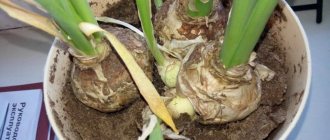The article describes in detail how to store tulip bulbs: preparing the bulbs, choosing a location, storage secrets, the best time for planting.
Gardeners will never come to a common decision: is it necessary to dig up tulips every year? Most are inclined to believe that there is no need to dig up plant bulbs every year, but once every few years you still have to do this, since the tulips become crowded, the soil is depleted, which means there is a high probability that your plants will not bloom next year. Therefore, every two to three years after the end of the growing season (when the leaves finally wither and wither, about a month after the end of flowering), the bulbs must be carefully dug up, inspected for diseases and mechanical damage, and prepared for storage.
How to store tulip bulbs: proper preparation of bulbs for storage
How to store tulip bulbs: proper preparation of bulbs for storage
But still, if you take growing tulips seriously, purchasing a variety of varietal bulbs, then you need to know that some species still require annual digging.
All tulips can be roughly divided into three groups: 1. Species belonging to the first group must be removed from the ground every year. These include terry and fringed varieties, green and parrot varieties, as well as “Rembrant tulips”. 2. The second group includes species that can grow for two years in one flowerbed: “triumph tulips”, Darwin hybrids and ordinary species. 3. The third group is the least capricious; flowers feel good in their “familiar” place for up to five years. These are tulips by FOSTER, KAUFMAN, GREIG.
They dig up the bulbs not only to transplant them to a new place, but mainly to carry out mandatory work: dry them, carry out preventive treatment against diseases, separate the newly formed “babies” so that the plants are not crowded and have enough nutrition. This is necessary to preserve varietal characteristics, as well as to ensure that the bulbs do not sink to depth and disappear without a trace. Although sometimes even very careful care does not help preserve varietal characteristics, and in the second year you may see branches of a completely different color and shape. Well, then, when you replant tulips every year, each time you prepare a new flowerbed with nutritious soil especially for them, and therefore the plant will be comfortable and it will delight you with flowering.
In order for the bulbs to be well preserved until the next planting, they must be promptly and carefully removed from the ground. After flowering ends, cut off the stem, leaving at least a couple of leaves necessary for the photosynthesis process. After about a month, these leaves will completely wither, which means the bulb has accumulated a sufficient supply of nutrients and is ready to go into a dormant state.
It is necessary to dig up the bulbs in dry weather; it is preferable to use a pitchfork rather than a shovel. Gently pry up the soil and select the bulbs, shaking or scraping away any remaining soil. When you dig up all the bulbs, rinse and carefully inspect the material - only healthy bulbs without signs of rot, insect penetration or scratches can be stored. If you find damage, try carefully cutting it off with a very sharp and disinfected knife, and sprinkle the cut area with activated carbon. And even after this operation, it is better to store such bulbs separately from those whose health is beyond doubt.
After sorting, prepare a light pink solution of potassium permanganate and soak the bulbs in it for half an hour (separate healthy ones from suspicious ones), and then dry them until completely dry. Instead of potassium permanganate, you can use any fungicide.
If you have different varieties of tulips growing on your site, then even before digging you need to prepare separate containers with the name of the variety or color and at each stage put the bulbs in their own boxes, otherwise during the process of preparation and storage everything will get mixed up and you will not be able to determine where what sort of.
What to do with the bulbs after drying
After final drying, the seed is prepared for sorting and storage:
- Each tuber is inspected, dry, easily separated scales are removed.
- The above-ground part is carefully cut with pruning shears or small garden shears, but not too deep, so as not to damage the root.
- Disinfect for 30 minutes in a pale pink manganese solution and dry.
How to store tulip bulbs before planting: where to place them for storage
How to store tulip bulbs before planting: where to place them for storage
After all treatments, dry the tulip bulbs for several days in a dry and well-ventilated room; a country attic is ideal for this. The main thing is that the bulbs should not be exposed to direct sunlight. Then remove the remaining roots and remove the old scales; if the bulbs have dried well, the scales will separate without any problems. Separate the “babies” from the mother bulb if they have not fallen off on their own. Healthy almost round bulbs with a diameter of four or more centimeters are ideal planting material; smaller bulbs most likely will not bloom next year; they still have to grow. You have to decide whether to plant them together with the rest of the bulbs of this variety, or plant all the “babies” separately so that they grow and gain strength.
In the first month of storage, the air temperature should be 24 degrees, and for some varieties +27...+30 degrees. You also need to maintain a humidity level of 60-70%. It is in the first month that flower buds begin to form, so maintaining temperature and humidity is very important. In the second month, the temperature is lowered to +19...+22 degrees, and with the onset of the third month to +14 degrees (this is the temperature regime that Dutch specialists adhere to, who, as you know, know a lot about tulips).
It is recommended to store flowers in cardboard boxes, wooden or plastic boxes, spreading the planting material in one layer. The boxes themselves can be placed under the bed, on the mezzanine or on a shelf in the pantry - the main thing is to ensure good ventilation. Remember, how you preserve the bulbs directly determines whether they will bloom next year.
You can make a waterproof box, equip it with a thermometer and place all the bulbs there, then this structure can be stored on the balcony, where there will be the best ventilation. Of course, there are specialized thermal chambers, but if you do not grow tulips on an industrial scale, then this is a rather expensive device. Although domestic craftsmen are able to build such a device from improvised means, having obtained all the necessary knowledge on the Internet. The most important thing in storage conditions is the absence of direct sunlight, constant and good ventilation, certain air humidity, as well as maintaining a temperature schedule that is most comfortable for tulip bulbs.
Drying rules
Flower bulbs should be dried in well-ventilated areas. Gazebos, canopies, dry basements, verandas, attics, and balconies are suitable for this purpose. The main thing is to make sure that the temperature is maintained, not higher than 25 degrees.
Direct sunlight is harmful to rhizomes. Only diffused light, semi-darkness or shaded conditions are suitable for harmless drying.
How to store tulip bulbs at home: secrets
How to store tulip bulbs at home: secrets
This paragraph contains not theoretical information or recommendations from Dutch experts, but real advice from experienced summer residents who have been working with flowers on their plots for years and have accumulated considerable practical experience. Whether you listen or not is up to you, but it’s definitely worth checking out, in case it comes in handy?
1. It is very important to carefully dig up the bulbs. A cut with a shovel or pitchfork, or even just the slightest scratch, can open a loophole for infection. 2. If the bulbs are stored in a room with very high humidity, then they must be sprinkled with sawdust, as this material absorbs excess moisture. 3.Where the bulbs are stored should always be dark. Otherwise, sprouts may appear before you plant the tulips. 4.A categorical “no” to plastic bags! Ventilation is very important during storage, but this is not possible when using polyethylene. 5. If you wrap each bulb individually in newspaper, this will increase the chances of preserving the material - the bulbs are better protected from moisture loss and will not suffer from unexpected temperature changes. 6.If you did not have time to plant tulips in the fall and need to save them until spring, then wrap each bulb in a sheet of newspaper and put them in a paper bag or linen or cotton bag. These bulbs should be stored in the refrigerator in the vegetable compartment. 7. Continuation of point No. 6 - every couple of weeks the bulbs from the refrigerator should be inspected. If signs of disease are found, for example, mold, then it is carefully scraped off, the onion is disinfected with a light pink solution of potassium permanganate, dried for three days and returned to storage. 8.If you have a basement and it is dry enough, then the planting material can be laid out directly on the shelf of the rack.
The main thing is not to forget to carry out inspections. In winter, the temperature in the basement should be maintained around +2…+4 degrees. The ideal time to plant tulips is autumn. The bulbs should have time to take root before frost, but should not begin to grow (and this sometimes happens if the autumn is very warm). This is approximately mid-October, but of course, first of all, we need to start from the current weather conditions.
When is the best time to plant
Unlike other types of ornamental plants, it is better to plant tulips in the fall. The optimal time for this event is the second and third ten days of September or the first week of November. During this period, the soil at a depth of 15 cm has a temperature of 10 to 13⁰ C.
Cooling during this period stimulates the plant to form sprouts and lay buds. Plants of the bulbous family cannot bloom without pre-cooling. Timely planted material has time to take root and tolerates frost well. If tulips are planted in the ground after the top layer of soil has frozen, then the planting should be well covered with brushwood, peat or other insulation.
Choosing the best time to land
Choosing the right time for planting is no less important than ensuring proper storage of planting material. If you delay and plant too late, the bulbs may not have time to take root and then there is a chance that they will die in the winter. If you plant it too early, the tulip will begin to grow, the sprout will appear on the surface of the ground, and at this moment frosts will most likely strike. Even if the sprouted bulb does not die, it most likely will not be able to bloom next year, producing only foliage.
At the time of planting, the soil temperature should be +7...+10 degrees, and the air temperature +3...+6 degrees; it will take about three weeks for the tulip bulbs to fully root.
Our country is large and planting dates may vary depending on the climate. In the central zone, tulips are planted in the first half of October, in Siberia this can be done as early as the end of August (if the weather is warm, then it can be done in September). In the Urals, planting should be carried out in the second half of September (you can capture the first days of October). And in the southern regions they plan to plant tulips at the end of October or even at the beginning of November.
Prepare the soil thoroughly before planting. Remember that all bulbous plants do not tolerate stagnant liquid, so you need to make sure that the soil is not too dense and provide the necessary drainage (if necessary, remove the layer of soil and fill in expanded clay). If your site is dominated by clay, then add sand or peat, this will make the soil more breathable and nutritious. If the soil, on the contrary, is sandy, then compost should be added to it, as well as enriched with mineral fertilizers.
After the soil for tulips is prepared, mark furrows or holes for the bulbs and water them with a solution of potassium permanganate (for disinfection). The planting depth of a tulip is usually equal to triple the height of the bulb; the distance between the bulbs should be at least 12 cm. In loose soil, the bulbs can be buried a little more, but in dense and heavy soil, on the contrary, less. Small onions, from which we do not yet expect to bloom, can be planted closer to each other.
Before planting, it is recommended to dust the bulbs with ash; this will provide both additional fertilizer and protection from fungal infections. When lowering the bulb into the ground, apply a little pressure to prevent the formation of an “air pocket”. Then fill the holes or furrows with soil and level the surface. If there is no rain in the next week, be sure to water the tulip bed so that the root system can fully develop.
There is no clear opinion whether it is necessary to cover tulips during frosts or whether snow cover will be enough for them. But since it requires very little effort and will increase the chances of your plants having a favorable winter, I strongly recommend that you mulch the soil around the bulbs. You can use straw, dry leaves, spruce branches or fallen pine needles for this. But do not forget to remove the mulch in a timely manner in the spring so that the tulips have access to sunlight.
Please note that agricultural stores and garden centers sell special baskets and containers for growing bulbous flowers (not only tulips, but also daffodils, crocuses, hyacinths). This is very convenient; in this case, the bulbs are placed in a basket with fertile soil (there are holes in the bottom of the basket or container), and only then the basket is placed in a recess in the flowerbed. This method allows you not to lose the bulbs, ensures their safety when removed from the ground, and also protects them from damage by mice.
Diseases, quality determination
The quality of flowers is determined by their appearance:
- The leaves are a juicy, bright green color.
- The stem is quite thick, up to 1 cm in diameter.
- The tip of the stem closer to the cut is white.
- Stem length is 40-60 cm (if less, then the tulip variety is low).
- The bud is closed.
- The bulbs are without flaws, hard, brown husk.
If the leaves have gray or yellow spots, then the plant is affected by a fungus (gray rot). This is caused by keeping the flower in the cold coupled with dampness. Damaged leaves must be eliminated, because... if the stem is damaged, the tulip will die.
Watery bulbs with a pink spot is a soft rot that will sooner or later lead to the flower wilting. The reason is planting in warm soil (above +12 °C). If a lesion is detected, it is necessary to disinfect the soil with a fungicide or renew it, and also be sure to drain it.
In addition to these diseases, there are: fusarium, typhullosis, root rot, penicillosis, trichoderma, August disease - the fight against each of them comes down to maintaining optimal growing conditions, excluding contaminated elements, treating and disinfecting tools with formaldehyde, and beds and bulbs with potassium permanganate and fungicide .
Regular checking of seed
Primary processing before storage is often not enough. All bulbs must be periodically turned over and inspected for the appearance of new spots and rottenness. Damaged roots are immediately removed, and those adjacent to them are wiped with a clean cloth and placed in a separate box to avoid further spread of bacteria.
Tips and tricks for proper storage
- The fundamental conservation recommendation for both tulips and their bulbs is compliance with temperature conditions, air humidity, and room ventilation.
- Elimination of sudden changes in environmental parameters.
- The sun is the enemy of cut tulips, but so is temperature below 0°C.
- The use of disinfectants when forcing and storing tulips has a positive effect on the result.
- Tulips love to be treated with care (without strong, tight packaging and dense materials).
- It should not be allowed to be adjacent to any other flowers and in no case to fruits.











